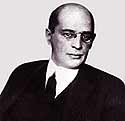I promised also to say something about Leo Perutz, whose Der Mangowunderbaum (co-written by Paul Frank) I read while by the cabin last week. Its Finnish translation from 1930 is called Salattu voima/The Hidden Power, which is pretty appropriate - this guy really has some hidden powers!
It's a very mysterious and intricate novel, with a doctor getting called into the house of a known mountain climber and adventurer. His Indian gardener is sick after getting bitten by a exotic snake. It seems at first that the mountain climber is a crumpy old man, already falling into pieces, and next day he's as vigorous as you'd guess from his reputation. The man's daughter is a very beautiful young woman, but she acts like she's ten years old. Also her father won't allow her to see her reflection in a mirror and smashes them all. It's all revealed in the end and you just keep guessing.
It's no wonder Perutz wrote pretty much at the same time as the Germans dabbled in the weird expressionistic cinema - Perutz's novels could've made some interesting films.
Perutz was an Austrian writer who dabbled in mystic adventures. His best known novel is The Swedish Cavalier (1936) and it's surely one of the best historical novels I've ever read. It's something between Jorge Luis Borges and Rafael Sabatini (and sure enough, Borges praised Perutz highly). I've also read his The Master of the Day of Judgment, which beats the Dan Browns hands down. From Nine to Nine (don't know if this one has been translated in English) is also a very interesting story about a man who keeps running through the city with his hands hidden from sight.
So, Perutz is highly recommended, especially since there are quite recent English translations - all the Finnish ones are over 60 years old and hence a bit dated.
 |
| Perutz in 1928 |
.

No comments:
Post a Comment